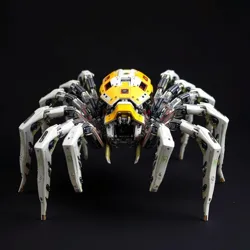Biomechanical Arthropod

A Biomechanical Arthropod is a synthetic organism that combines advanced robotics with biological design principles inspired by natural arthropods. These sophisticated machines, first developed by Synthetic Evolution Labs in 2155, represent a cornerstone achievement in bio-mechanical engineering and synthetic organism design.
Structure and Design
Biomechanical arthropods feature a sophisticated exoskeleton composed of quantum-responsive alloys that mimic the segmented structure of their biological counterparts. Their bodies house advanced micro-fusion cores for power generation and contain complex networks of synthetic neurons that enable sophisticated decision-making capabilities.
Key Components
- Adaptive exoskeleton with self-repairing capabilities
- Neural processing units based on quantum computing architecture
- Synthetic muscle fibers utilizing nano-scale actuators
- Environmental sensors with molecular-level detection abilities
Applications
Industrial Use
Biomechanical arthropods serve crucial roles in various industries, particularly in: - Precision manufacturing - Hazardous environment exploration - Infrastructure maintenance - Micro-assembly operations
Environmental Monitoring
These synthetic creatures excel at environmental data collection and analysis, using their advanced sensor arrays to monitor: - Atmospheric conditions - Pollution levels - Ecosystem stability - Quantum field variations
Types and Classifications
The most common variants include:
- Hextron Beetles - Specialized in heavy lifting and construction
- Synthetic Arachnids - Focused on precision work and web-based structures
- Mechanical Centipedes - Designed for tunnel navigation and maintenance
Recent Developments
Recent advances in quantum-organic integration have led to enhanced cognitive capabilities and improved environmental adaptation. The latest generation features advanced swarm coordination abilities and enhanced self-repair mechanisms.
See Also
- Synthetic Evolution
- Quantum Arthropod Design
- Biomechanical Engineering Standards
References
- Advanced Robotics Quarterly
- Journal of Synthetic Biology
- Biomechanical Engineering Review